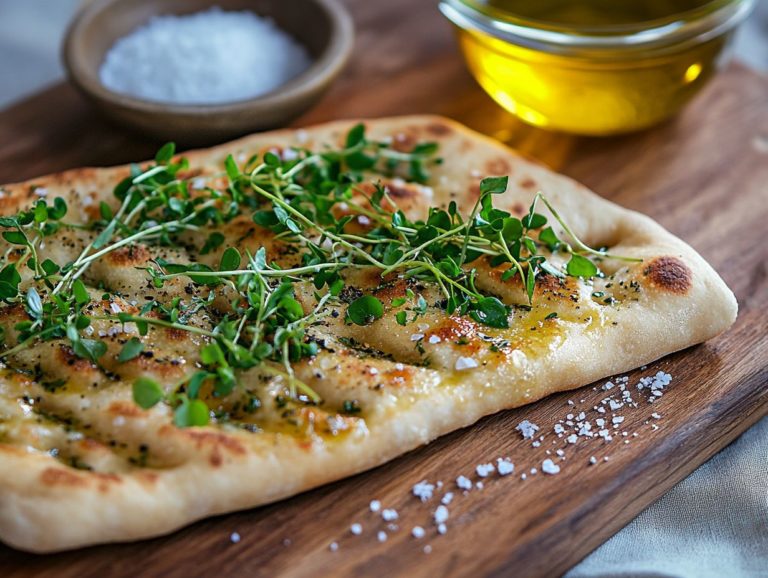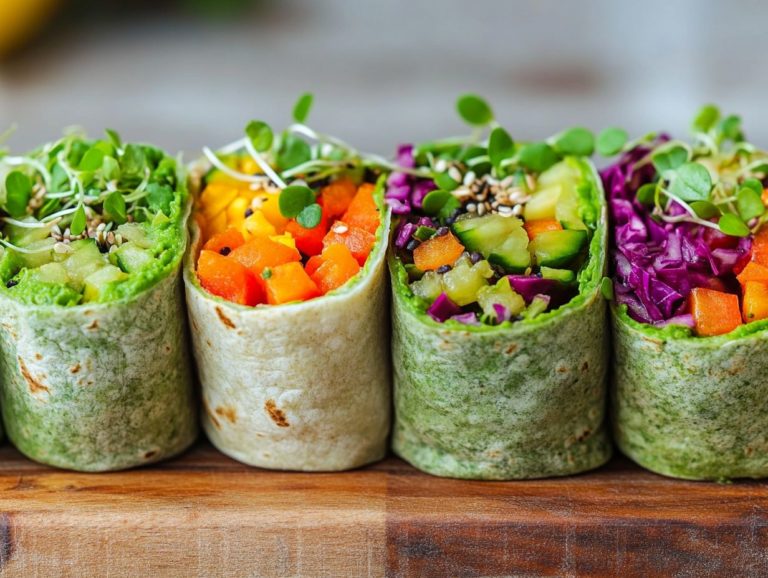31. Microgreens in Mediterranean Cuisine: A Guide
Microgreens aren’t merely trendy garnishes; they offer an explosion of flavor and nutrition, particularly in Mediterranean cuisine, aligning perfectly with the principles of the Mediterranean diet.
Explore the myriad benefits of these tiny greens, from their outstanding nutritional profiles, including crucial vitamins like ascorbic acid and tocopherol, to their versatile culinary applications.
Discover how to effortlessly weave microgreens into your favorite Mediterranean dishes, complete with delectable recipes and serving suggestions that highlight their sensory attributes.
Uncover tips for growing your own microgreens with simple and effective techniques, and learn about the best varieties to elevate your cooking experience.
Get started now and discover the incredible potential of these vibrant greens!
Contents
- Key Takeaways:
- Benefits of Microgreens in Mediterranean Cuisine
- How to Incorporate Microgreens into Mediterranean Dishes
- Growing Your Own Microgreens
- Choosing the Right Varieties for Your Dishes
- Frequently Asked Questions
- What are microgreens?
- What are some popular types of microgreens used in Mediterranean cuisine?
- How are microgreens typically used in Mediterranean dishes?
- What are the health benefits of incorporating microgreens into Mediterranean cuisine?
- Are there any specific storage or handling tips for microgreens?
- Can I grow my own microgreens at home?
Key Takeaways:
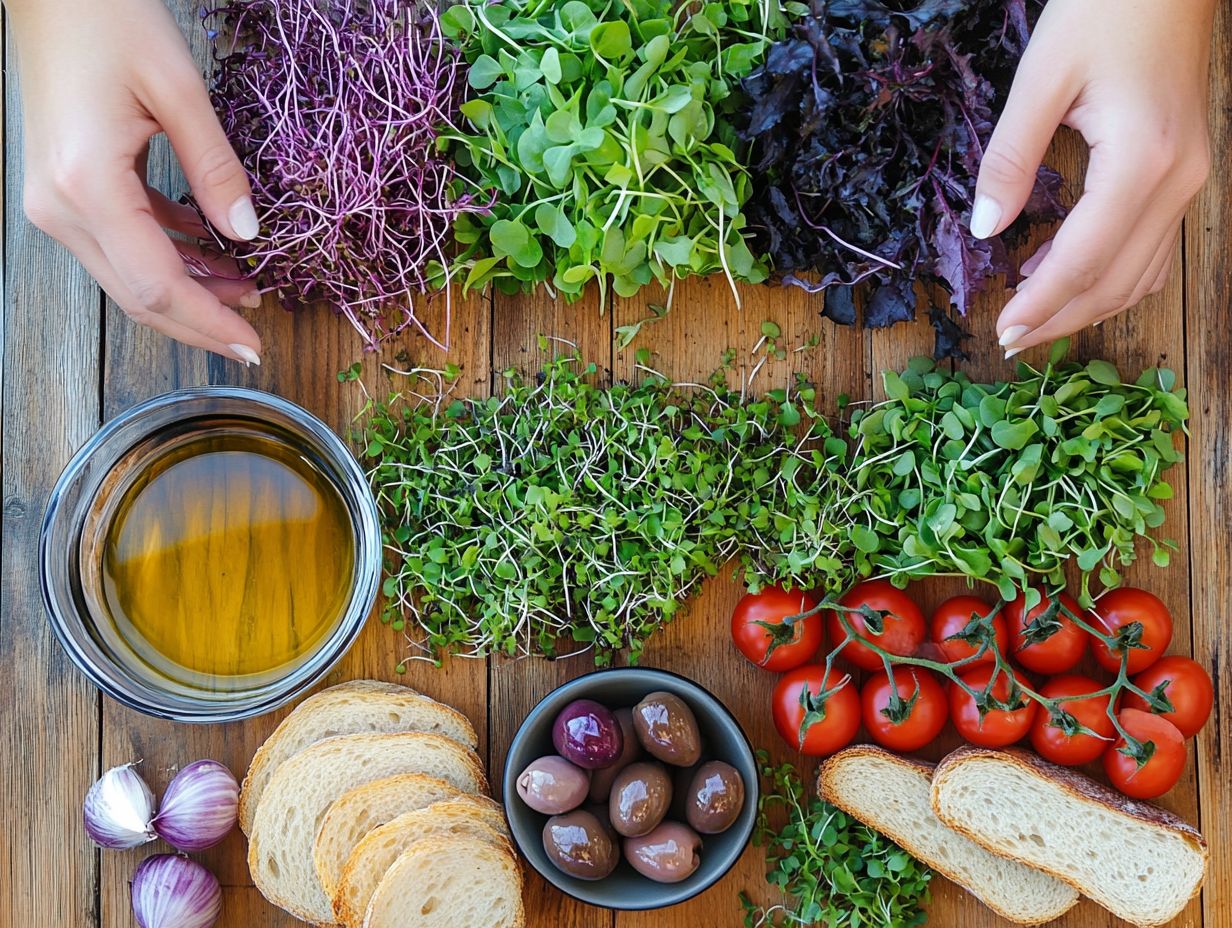
- Microgreens are young plants with concentrated nutrients, adding flavor and texture to Mediterranean dishes, making them popular in high-end restaurants.
- Incorporate microgreens into your diet for their unique health benefits and versatility in cooking.
- Growing your own microgreens is easy and cost-effective, with various options to choose from for different Mediterranean flavors and health benefits.
What are Microgreens?
Microgreens are young, edible plants that you harvest just after the first true leaves have developed. They re gaining recognition for their remarkable health benefits and culinary versatility. These vibrant greens are packed with high levels of natural compounds found in plants that promote health and phytonutrients, acting as superfoods that can elevate any dish, whether it’s a simple salad or a gourmet meal.
Their high nutrient levels far exceed those of standard vegetables, making them a coveted choice for health-conscious consumers, especially in high-end restaurants, and for combating malnutrition.
Typically, microgreens are harvested between 2 to 3 weeks in age, and they come in a delightful variety, such as radish, basil, and broccoli, each offering its own unique flavors and aromas. Their increasing popularity in urban farming is largely due to how effortlessly they can be cultivated in limited spaces, allowing city dwellers to grow their own food.
This movement promotes sustainability while providing a fresh source of produce that is essential for enhancing diets.
The high antioxidant levels in these tiny greens help combat chronic diseases like obesity, diabetes, and cardiovascular conditions, making them an essential addition to a balanced diet.
As more individuals recognize these benefits, the microgreens trend is set to flourish even further, capturing the interest of both novice gardeners and seasoned chefs alike.
Benefits of Microgreens in Mediterranean Cuisine
Incorporating microgreens into Mediterranean cuisine elevates not just the visual appeal of your dishes often dubbed ‘vegetable confetti’ but also significantly enhances their health benefits. This makes them a versatile addition to functional foods and fresh meals.
Packed with plant nutrients and phytonutrients, microgreens bring unique flavors and textures that beautifully complement traditional Mediterranean ingredients, aligning perfectly with modern culinary trends.
Nutritional Value and Culinary Uses
Microgreens are celebrated for their remarkable nutritional value, offering higher concentrations of vitamins like ascorbic acid, tocopherol, and carotenoids compared to their mature counterparts. This makes them perfect for culinary applications, whether you’re garnishing gourmet dishes in upscale restaurants or simply elevating your everyday meals with a burst of flavors and nutrients.
Consider red cabbage microgreens, which provide a vibrant crunch along with significant vitamin C content. Cilantro brings lively flavor and detoxifying properties to the table, while radish microgreens deliver a peppery punch along with impressive antioxidant levels.
In Mediterranean cuisine, these tiny greens can transform simple salads, complement fresh fish dishes beautifully, and serve as a unique topping for pizzas or spreads. Their diverse flavors not only enhance any dish but also contribute to a remarkable nutrient density, making them a valuable addition to a health-conscious diet.
How to Incorporate Microgreens into Mediterranean Dishes
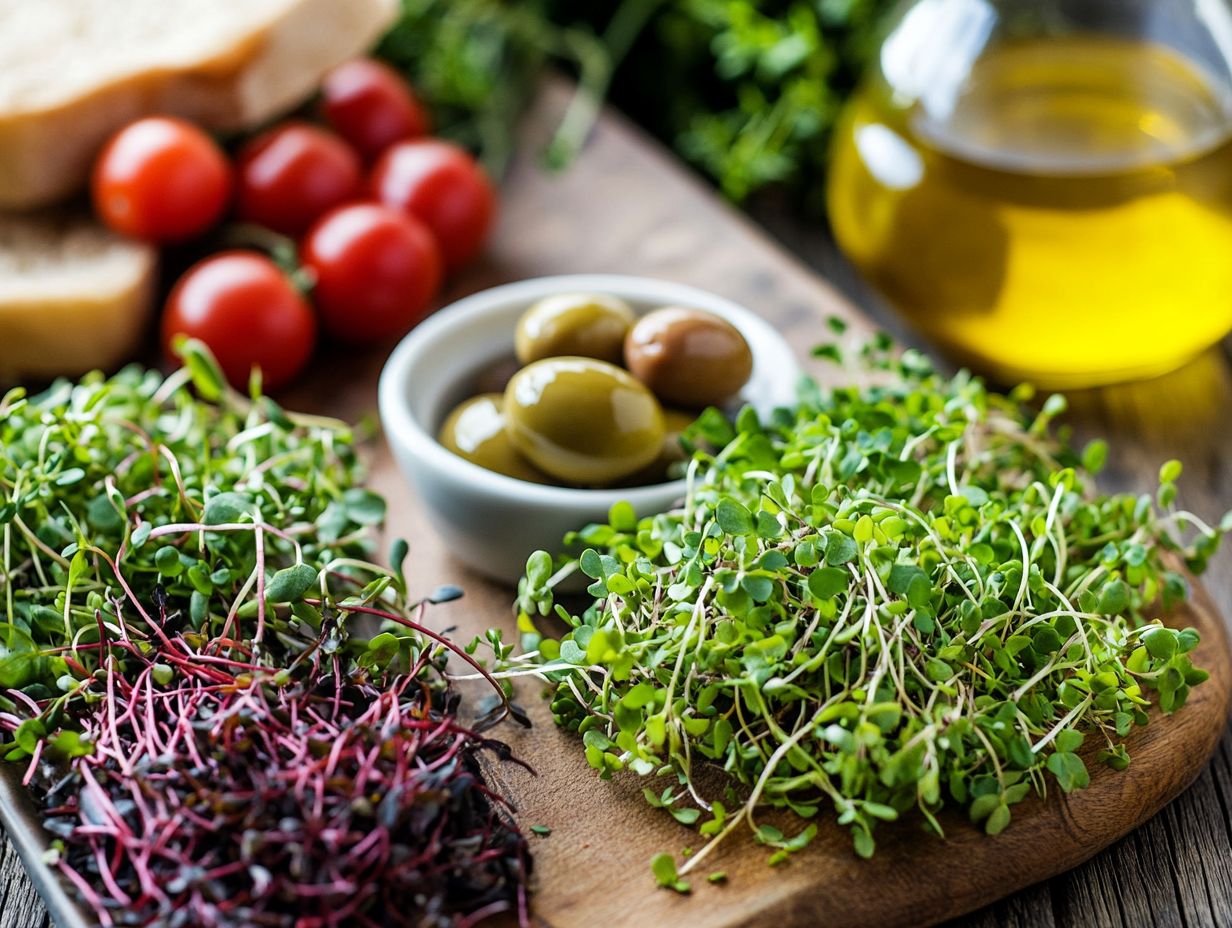
Incorporating microgreens into your Mediterranean dishes can elevate your culinary experience to new heights. These vibrant greens add a splash of color, intriguing textures, and a treasure trove of nutrients, making them a beloved choice among cooking enthusiasts and health-conscious diners alike.
Whether you’re crafting a salad or perfecting a pasta dish, these versatile microgreens seamlessly enhance both the flavor and nutritional profile of your favorite traditional recipes.
Recipes and Serving Suggestions
Exploring a variety of recipes that utilize microgreens will ignite exciting new culinary adventures, especially in Mediterranean cuisine, where fresh ingredients and vibrant flavors reign supreme.
Picture a plate bursting with color, where the delicate textures of arugula or radish microgreens elevate a traditional tabbouleh, introducing an unexpected twist. These tiny greens enhance visual appeal and contribute essential nutrients, making them the perfect choice for health-conscious diners. For a deeper dive, consider exploring microgreen varieties in different cuisines.
When you incorporate them into Mediterranean staples like bruschetta or grilled vegetable skewers, they add a crisp freshness that beautifully complements the rich flavors typical of the region’s cuisine. For those looking to explore their options, a quick guide to common microgreen varieties can help you creatively integrate microgreens into your dishes, enriching the sensory experience of meals and inspiring delightful conversations around the table.
Growing Your Own Microgreens
Start growing your own microgreens today and enjoy fresh, nutrient-packed greens at any time! Growing your own microgreens is an enriching pursuit that not only enables you to relish fresh, nutrient-dense greens at your convenience but also contributes to urban farming initiatives and fosters a sustainable lifestyle.
With straightforward growing techniques, you can effortlessly cultivate these superfoods in even the smallest of spaces, elevating both your diet and your culinary creativity.
Tips and Tricks for Successful Cultivation
Successful cultivation of microgreens hinges on your understanding of specific growing techniques that foster optimal growth and flavor. Implementing these tips can transform your microgreen garden into a thriving oasis that enhances your culinary creations.
- Ensure your growing area receives adequate light aim for 12-16 hours each day, using either natural sunlight or grow lights.
- Effective watering is crucial; keep the soil consistently moist but not waterlogged. A spray bottle or a bottom watering technique can work wonders.
- When it s time to harvest, cut the microgreens just above the soil line with clean scissors to achieve the best flavor and texture.
By incorporating these practices, you’ll not only cultivate your own nutrient-rich greens but also contribute to a sustainable urban farming environment, ultimately paving the way for a healthier lifestyle.
Choosing the Right Varieties for Your Dishes
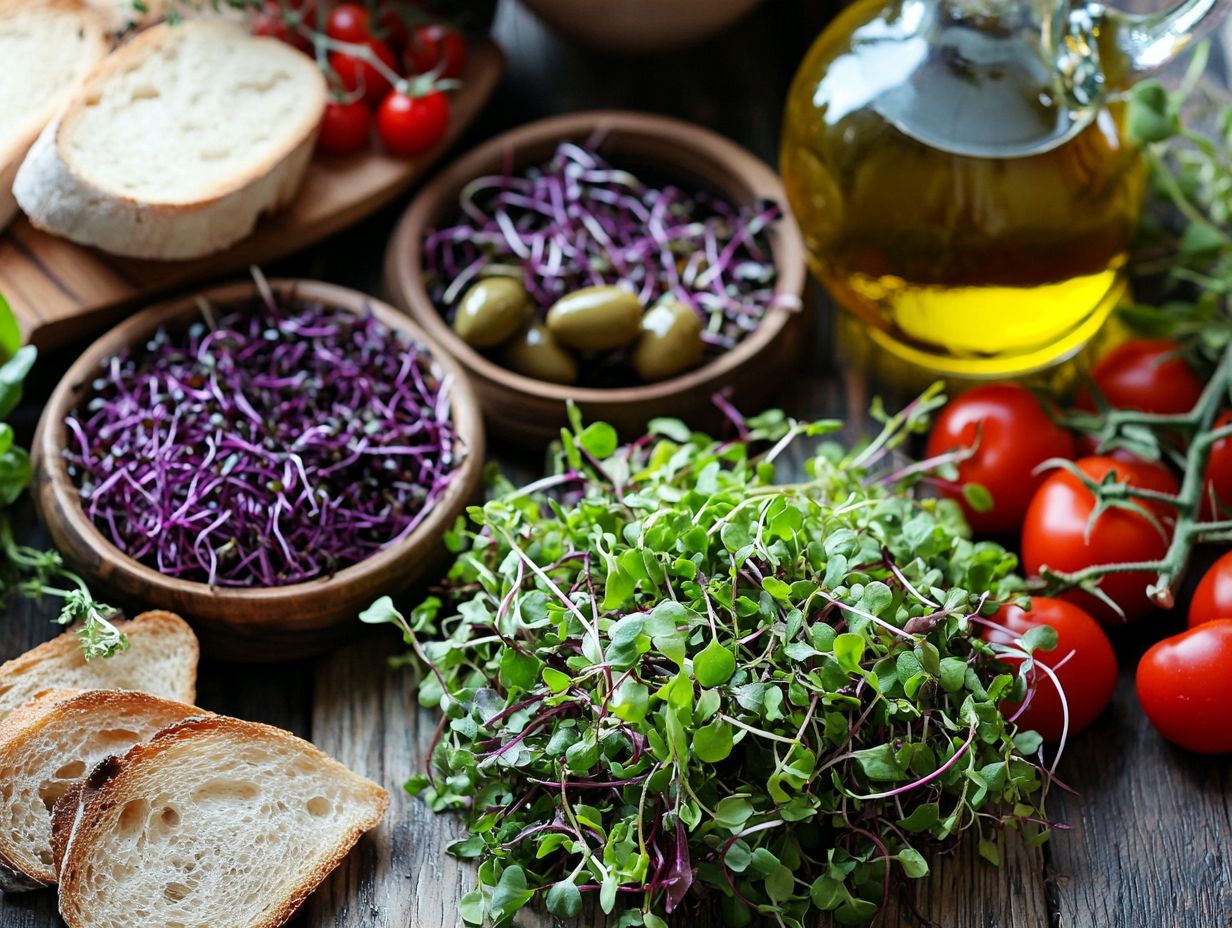
Selecting the right varieties of microgreens for your dishes is essential for complementing flavors and elevating the overall dining experience, particularly in Mediterranean cuisine where vibrant tastes and fresh ingredients align with the Mediterranean diet.
With such a diverse selection at your fingertips, understanding how each microgreen variety can impact a dish will significantly enhance your culinary creations. For detailed insights, check out our guide to harvesting microgreens for cooking.
Popular Microgreens in Mediterranean Cooking
Popular microgreens like radish, cilantro, and red cabbage have become the stars of Mediterranean cooking. Their unique sensory attributes elevate your dishes visually and nutritionally. These microgreens add vibrant color and rich flavor. They transform traditional recipes into gourmet experiences, making them staples in high-end restaurants.
Consider the crisp, peppery notes of radish microgreens. They can take your simple tabbouleh salad and turn it into a standout dish that truly tantalizes your taste buds. Similarly, cilantro microgreens offer a fresh, citrus-like aroma. They pair beautifully with grilled fish or roasted vegetables, while their delicate texture provides a lovely contrast. To explore more about the different microgreen varieties and their flavors, check out our guide!
Then there are red cabbage microgreens, boasting a striking purplish hue. They not only serve as a stunning garnish on a Mediterranean-style mezze platter but also enhance the savory elements of dips like hummus. For those interested in growing these delicious greens, check out microgreen varieties: a guide for beginners. Incorporating these microgreens boosts flavor and makes each plate visually appealing, transforming everyday meals into delicious meals!
Frequently Asked Questions
What are microgreens?
Microgreens are young vegetable greens, such as herbs and leafy greens, harvested when they are just a few inches tall. They are packed with nutrients and known for their intense flavor.
What are some popular types of microgreens used in Mediterranean cuisine?
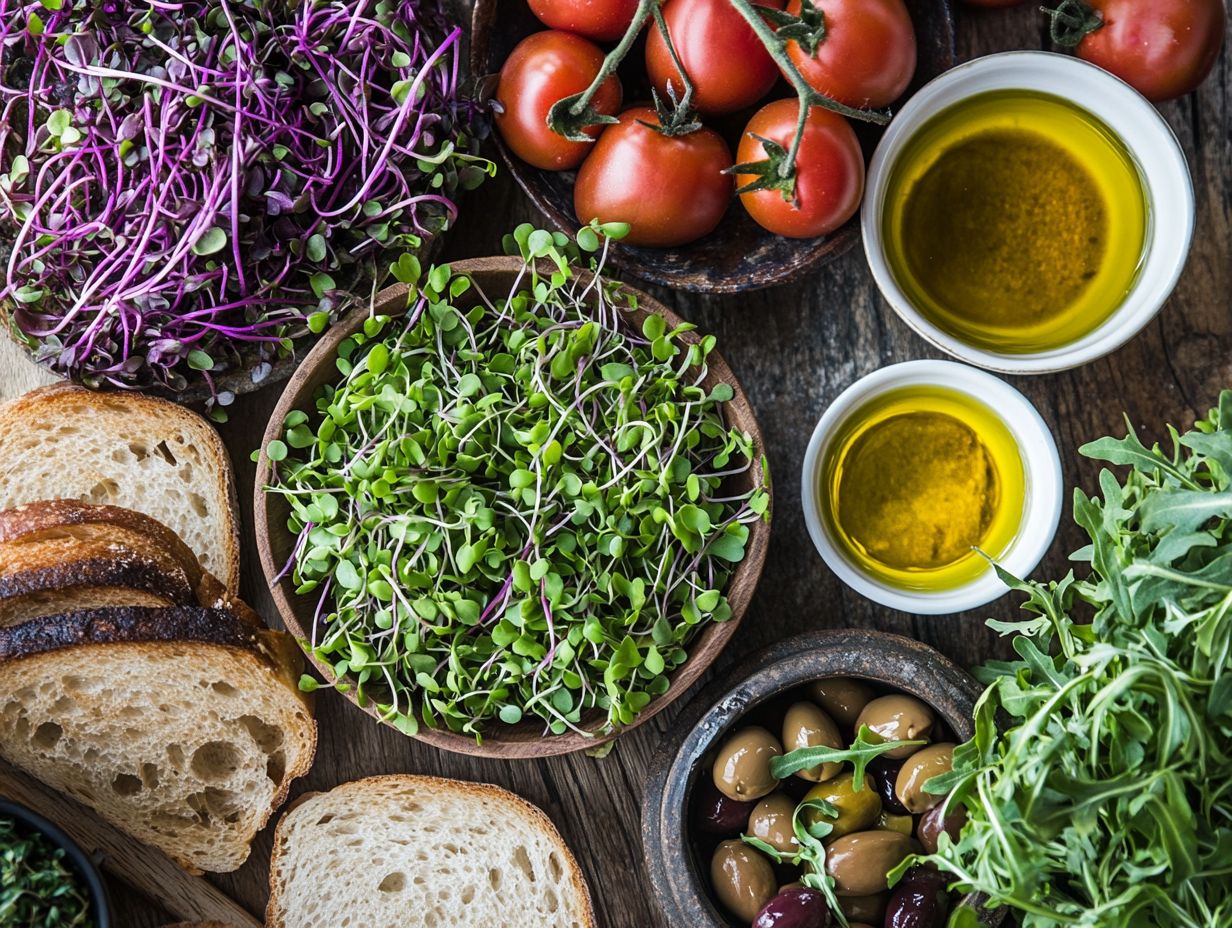
Some popular microgreens used in Mediterranean cuisine include arugula, kale, basil, cilantro, and parsley. Other commonly used microgreens include radish, broccoli, and mustard greens.
How are microgreens typically used in Mediterranean dishes?
Microgreens are often used as a garnish or topping for Mediterranean dishes. They add a pop of color and flavor. They can also be used in salads, sandwiches, and as a base for dips and spreads.
What are the health benefits of incorporating microgreens into Mediterranean cuisine?
Microgreens are highly nutritious, containing significant levels of vitamins, minerals, and antioxidants. They are also a great source of fiber and can help boost the immune system and improve overall health.
Are there any specific storage or handling tips for microgreens?
Handle microgreens with care they re delicate and deserve your attention! They should be stored in the refrigerator and kept dry until ready to use. They can last up to a week in the fridge, but it is best to use them within a few days for optimal freshness.
Can I grow my own microgreens at home?
Yes! Microgreens can easily be grown at home with minimal space and equipment. You can purchase microgreen growing kits or use materials like trays, soil, and seeds to grow your own. The process usually takes 1-2 weeks and can provide a continuous supply of fresh microgreens for your Mediterranean dishes. Don t miss out on the vibrant flavors microgreens bring to your meals try them today!


